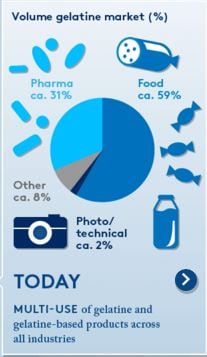This is the message the company’s research and application director Dr Paul Stevens will deliver at the industry event Food Ingredients Europe (FiE) next month in Paris.
Speaking with us ahead of the event, Stevens said: “We are saying gelatine is more than just a texturiser. It is a multifunctional protein.”
Rousselot has been working with Dutch start-up Fortified Food Coatings BV, which uses gelatine to form fortified coatings for ready meals.
This marked a new functional direction for Rousselot, Stevens said.
Gelatine contains 84-90% protein, 1-2% mineral salts and the rest is water, according to Gelatine Manufacturers of Europe (GME).
Fashionably functional?
Euromonitor International said protein sales within sports nutrition brought in global sales of $8.1 billion (€7.62 billion) in 2014.
Algae, pulses and even insects have been on the tip of tongues as novel sources of protein.
Indeed according to research firm Mintel, 25% of UK consumers have cut down their consumption of animal protein.
In a roundup of food trends for 2016, Mintel said: “The growing ranks of novel protein sources and potential replacements appeal to the everyday consumer, foreshadowing a profoundly changed marketplace in which what was formerly ‘alternative’ could take over the mainstream.”
So is gelatine – made from collagen from various animal by-products – in line with consumer protein expectations?
Stevens conceded there had been a lot of hype around novel plant sources of protein. Yet, he said, the functionality of gelatine spoke for itself.
The company was also pushing its Peptan range for skin, bone and joint health from functional food, cosmetics and supplements.

At FiE it will be showcasing collagen-enriched coffee as well as cereal bars and gummies.
Making a come back
Stevens said gelatine and other animal ingredients had also suffered in recent years because of incidents like the outbreak of bovine spongiform encephalopathy (BSE), commonly known as mad cow disease.
“There were so many bad adverts around gelatine – we all remember mad cow disease,” he said.
The last outbreak in the 1990s in the UK saw 180,000 cattle affected and 4.4 million cows killed.
Yet Stevens said gelatine’s safety was proven and the ingredient was now moving forward to rebrand itself as a 'clean label' protein. Gelatine is not an E number on food labels.
In 2006 the European Food Safety Authority (EFSA) was asked to assess the risk of contracting the human version of BSE - Variant Creutzfeldt-Jakob disease (vCJD) - from animal byproducts like gelatine.
In the opinion EFSA concluded: "Inclusion of vertebral column in the raw materials used to produce tallow and gelatine from bones or a mixture of tissues increases the level of human exposure by 3-10 fold. However, the levels of residual BSE risk for these products calculated in the QRA [quantitative risk assessment] are low and the increased risk factor due to inclusion of vertebral column is unlikely to translate into further cases of vCJD [Variant Creutzfeldt-Jakob disease] in the population. Therefore, in the case of tallow and gelatine, there appears to be no rationale for imposing an age-limit above which to exclude vertebral column from the batches of raw materials used to produce these by-products."
GME says the production of gelatine-like mixtures dates back to Ancient Egypt.
These days about 59% of gelatine is used for food in Europe, while 31% goes into pharma products.
